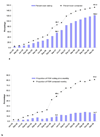Condom use and prevalence of syphilis and HIV among female sex workers in Andhra Pradesh, India - following a large-scale HIV prevention intervention
- PMID: 22376071
- PMCID: PMC3287547
- DOI: 10.1186/1471-2458-11-S6-S1
Condom use and prevalence of syphilis and HIV among female sex workers in Andhra Pradesh, India - following a large-scale HIV prevention intervention
Abstract
Background: Avahan, the India AIDS initiative began HIV prevention interventions in 2003 in Andhra Pradesh (AP) among high-risk groups including female sex workers (FSWs), to help contain the HIV epidemic. This manuscript describes an assessment of this intervention using the published Avahan evaluation framework and assesses the coverage, outcomes and changes in STI and HIV prevalence among FSWs.
Methodology: Multiple data sources were utilized including Avahan routine program monitoring data, two rounds of cross-sectional survey data (in 2006 and 2009) and STI clinical quality monitoring assessments. Bi-variate and multivariate analyses, Wald Chi-square tests and multivariate logistic regressions were used to measure changes in behavioural and biological outcomes over time and their association.
Results: Avahan scaled up in conjunction with the Government program to operate in all districts in AP by March 2009. By March 2009, 80% of the FSWs were being contacted monthly and 21% were coming to STI services monthly. Survey data confirmed an increase in peer educator contacts with the mean number increasing from 2.9 in 2006 to 5.3 in 2009. By 2008 free and Avahan-supported socially marketed condoms were adequate to cover the estimated number of commercial sex acts, at 45 condoms/FSW/month. Consistent condom use was reported to increase with regular (63.6% to 83.4%; AOR=2.98; p<0.001) and occasional clients (70.8% to 83.7%; AOR=2.20; p<0.001). The prevalence of lifetime syphilis decreased (10.8% to 6.1%; AOR=0.39; p<0.001) and HIV prevalence decreased in all districts combined (17.7% to 13.2%; AOR 0.68; p<0.01). Prevalence of HIV among younger FSWs (aged 18 to 20 years) decreased (17.7% to 8.2%, p=0.008). A significant increase in condom use at last sex with occasional and regular clients and consistent condom use with occasional clients was observed among FSWs exposed to the Avahan program. There was no association between exposure and HIV or STIs, although numbers were small.
Conclusions: The absence of control groups is a limitation of this study and does not allow attribution of changes in outcomes and declines in HIV and STI to the Avahan program. However, the large scale implementation, high coverage, intermediate outcomes and association of these outcomes to the Avahan program provide plausible evidence that the declines were likely associated with Avahan. Declining HIV prevalence among the general population in Andhra Pradesh points towards a combined impact of Avahan and government interventions.
Figures




Similar articles
-
Assessment of the scale, coverage and outcomes of the Avahan HIV prevention program for female sex workers in Tamil Nadu, India: is there evidence of an effect?BMC Public Health. 2011 Dec 29;11 Suppl 6(Suppl 6):S3. doi: 10.1186/1471-2458-11-S6-S3. BMC Public Health. 2011. PMID: 22375609 Free PMC article.
-
Targeted interventions of the Avahan program and their association with intermediate outcomes among female sex workers in Maharashtra, India.BMC Public Health. 2011 Dec 29;11 Suppl 6(Suppl 6):S2. doi: 10.1186/1471-2458-11-S6-S2. BMC Public Health. 2011. PMID: 22375562 Free PMC article.
-
Increase in condom use and decline in prevalence of sexually transmitted infections among high-risk men who have sex with men and transgender persons in Maharashtra, India: Avahan, the India AIDS Initiative.BMC Public Health. 2014 Aug 3;14:784. doi: 10.1186/1471-2458-14-784. BMC Public Health. 2014. PMID: 25086742 Free PMC article.
-
Structural determinants of HIV/STI prevalence, HIV/STI/sexual and reproductive health access, and condom use among immigrant sex workers globally.AIDS. 2021 Jul 15;35(9):1461-1477. doi: 10.1097/QAD.0000000000002910. AIDS. 2021. PMID: 34185713 Free PMC article.
-
HIV epidemiology among female sex workers and their clients in the Middle East and North Africa: systematic review, meta-analyses, and meta-regressions.BMC Med. 2019 Jun 24;17(1):119. doi: 10.1186/s12916-019-1349-y. BMC Med. 2019. PMID: 31230594 Free PMC article.
Cited by
-
Peer education for HIV prevention among high-risk groups: a systematic review and meta-analysis.BMC Infect Dis. 2020 May 12;20(1):338. doi: 10.1186/s12879-020-05003-9. BMC Infect Dis. 2020. PMID: 32398032 Free PMC article.
-
Anaesthesia for caesarean deliveries and maternal complications in a Nigerian teaching hospital.Afr J Med Med Sci. 2014 Mar;43(1):5-10. Afr J Med Med Sci. 2014. PMID: 25335372
-
Global epidemiology of HIV among female sex workers: influence of structural determinants.Lancet. 2015 Jan 3;385(9962):55-71. doi: 10.1016/S0140-6736(14)60931-4. Epub 2014 Jul 22. Lancet. 2015. PMID: 25059947 Free PMC article. Review.
-
Systematic Review of Peer-Reviewed Literature on Global Condom Promotion Programs.Int J Environ Res Public Health. 2020 Mar 27;17(7):2262. doi: 10.3390/ijerph17072262. Int J Environ Res Public Health. 2020. PMID: 32230929 Free PMC article.
-
Factors Influencing Abortion Among Brothel-Based Female Sex Workers in Rural West Bengal, India.Cureus. 2025 Jul 5;17(7):e87333. doi: 10.7759/cureus.87333. eCollection 2025 Jul. Cureus. 2025. PMID: 40761966 Free PMC article.
References
-
- National AIDS Control Organization (NACO) Annual HIV Sentinel Surveillance Country Report. New Delhi; 2006. http://www.nacoonline.org/Quick_Links/Publication/ME_and_Research_Survei... Accessed March 17 2011.
-
- Joint United Nations Programme on HIV/AIDS (UNAIDS); World Health Organization (WHO) AIDS epidemic Update. Geneva. Geneva; UNAIDS; 2007. http://data.unaids.org/pub/EPISlides/2007/2007_epiupdate_en.pdf Accessed March 17 2011.
-
- National AIDS Control Organization (NACO); Ministry of Health and Family Welfare. A Technical Brief. New Delhi; 2008. HIV Sentinel Surveillance and HIV Estimation 2007.http://www.nacoonline.org/upload/Publication/M&E%20Surveillance,%20Resea... Accessed March 17 2011.
MeSH terms
LinkOut - more resources
Full Text Sources
Medical

